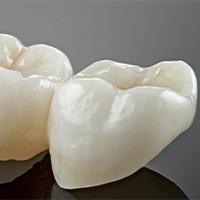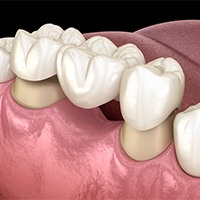Dental Bridges Owings Mills
Filling Gaps Left by Missing Teeth

No one plans on ever losing a tooth, but unfortunately, it’s still a possibility. When you’re facing the prospect of life with a gap in your grin, you should reach out to Dr. Milner to see what restorative dentistry options are available. In many cases, we can fill the space in your smile with a natural-looking, long-lasting dental bridge. If you would like to discuss this tooth replacement method with us in person, call today to schedule a consultation.
Why Choose Dolfield Dental of Owings Mills for Dental Bridges?
- In-Office Dental Implant Placement
- Tooth-Colored, Highly Durable Materials
- In-Network with Many Major Dental Insurance Plans
What is a Dental Bridge?

A dental bridge is a type of dental prosthesis that can be used if one tooth is missing. It can also sometimes be a viable option for patients who have lost multiple teeth that were all right next to each other.
To create your dental bridge, a number of artificial teeth called pontics will be suspended between a pair of dental crowns. Said crowns will be anchored to the teeth on either side of the gap being filled. (Sometimes the crowns can be attached to dental implant posts instead.) To put it simply, the pontics will serve as your new teeth while the crowns make sure that the prosthesis stays in place.
Each dental bridge is made out of tooth-colored materials and is customized to blend in with the rest of the smile. This means that in the eyes of the casual observer, your prosthesis will be virtually indistinguishable from your actual teeth.
Types of Dental Bridges

What kind of dental bridge do you need? Should you get a traditional bridge that uses natural teeth for support, or would an implant bridge be the better option for your smile? Our team is ready to help you make a decision; we’ll examine your mouth, clarify your personal smile goals, and take a look at your oral health history in order to determine the best option in your particular case.
Traditional Dental Bridge
To get a traditional dental bridge, you need to have healthy teeth on either side of the gap being filled. We will often suggest a traditional dental bridge if just one or two teeth are missing. Keep in mind that a small amount of enamel will need to be removed from the teeth supporting the bridge.
Implant Bridge
You might be a candidate for dental implants if there’s plenty of bone density in your jaw. An implant bridge can fill a gap left by three or more teeth in a row. Thanks to their unique ability to fulfill the functions of tooth roots, dental implants can stop the process of bone loss that often occurs when teeth have been lost.
The Benefits of Getting a Dental Bridge

If the empty space left by missing teeth is left alone, your remaining teeth may eventually start to drift out of place. But with a dental bridge, you can ensure that your teeth stay where they need to be for a properly aligned bite.
On top of that, you can easily take care of a dental bridge simply by giving it the same care as the rest of your smile (namely, brushing it at least twice a day). A well-maintained dental bridge can have a lifespan in the range of 5 to 15 years.
